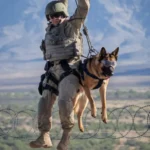Military working dogs play a vital role in missions, from detecting explosives to assisting in rescue operations.

Military working dogs play a vital role in missions, from detecting explosives to assisting in rescue operations.
To enhance the safety and effectiveness of these dogs and their handlers, a groundbreaking technology has been developed: augmented reality (AR) goggles for dogs.
This new tool allows handlers to give their dogs precise commands while keeping a safe distance, potentially transforming how these canines are deployed in the field.
Command Sight, Inc., a Seattle-based company, developed this AR system with funding from the Small Business Innovation Research (SBIR) program.
The AR goggles, which are custom-fit to each dog, provide a visual cue that directs the dog to specific locations. Meanwhile, the handler can see everything the dog sees through the goggles, giving them the ability to control the dog’s movements remotely.
Dr. Stephen Lee, a senior scientist with the Army Research Office (ARO), explains that AR for dogs is quite different from that used by humans.
It’s designed to communicate commands and cues to the dog rather than for the dog to interact with it as humans do. The initial results have been promising, but further research is needed before the system can be fully deployed in harsh military environments.
Currently, most military dogs are directed by hand signals or audio commands through cameras and walkie-talkies.
These methods have limitations, such as requiring the handler to stay within sight or leading to confusion when verbal commands are unclear. Augmented reality goggles could solve these issues by providing a clearer and more direct line of communication, reducing the risk of error.
The development of the AR goggles is still in its early stages. The initial prototype is wired, but researchers are working toward creating a wireless version.
To tailor the technology to each dog, the team uses 3D scans to design the most comfortable and effective fit for the optics and electrical components.
The military community, particularly Special Forces, is eager to see the results of this innovative technology.
By leveraging existing protective goggles that military dogs are already accustomed to, the AR system promises a smooth transition for both dogs and handlers.
The camera system integrated into the goggles offers a clearer view of what the dog sees, improving mission effectiveness and reducing errors.
Contents
Conclusion
The introduction of augmented reality goggles for military working dogs represents a significant advancement in the field.
By enhancing communication between handler and dog, this technology not only protects the handler but also increases the operational efficiency of the dog.
As research progresses, this innovation could redefine the role of military working dogs and open up new possibilities for future military operations.
FAQs
- What are augmented reality goggles for military working dogs? These are specially designed goggles that allow handlers to give dogs specific visual commands while staying at a safe distance, enhancing the dog’s effectiveness in the field.
- How do the augmented reality goggles benefit military dogs and handlers? The goggles allow handlers to control dogs remotely, reducing the risk to soldiers while improving communication during high-risk missions.
- What stage is the development of the AR goggles currently in? The project is still in the research and prototype phase, with a wired version currently in testing. A wireless version is under development for broader military use.
- How are the AR goggles tailored to each military working dog? Each dog undergoes a 3D scan to ensure that the goggles fit properly, allowing for the best placement of the optics and electrical components.
- Why is augmented reality needed for military dogs? AR goggles provide a more direct and precise method of communication than traditional hand signals or verbal commands, reducing the chance of confusion or error.
- What’s the next step in the development of these AR goggles? The team is working on a wireless prototype that will undergo field testing with Navy Special Forces before being adapted for broader military use.








